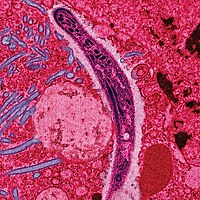
Photo from wikipedia
Plasmodium the causative agent of malaria is a member of the phylum Apicomplexa, where all invasive forms have a substrate-dependent motility called gliding, key to malaria transmission. Gliding allows parasite… Click to show full abstract
Plasmodium the causative agent of malaria is a member of the phylum Apicomplexa, where all invasive forms have a substrate-dependent motility called gliding, key to malaria transmission. Gliding allows parasite host-cell recognition, binding, cell entry and trespassing the cytoplasm. In this process Plasmodium releases molecules from micronemes and the cell surface that are deposited on trails left behind on the substratum as the parasite progresses. Previously we identified the heat shock protein 70-1 (HSP 70-1) on the surface and micronemes of P. berghei ookinetes, the parasite form that invades the mosquito midgut. To investigate if this protein is shed of from the parasite during invasion, we searched HSP 70-1 in gliding trails deposited on a solid surface by P. berghei ookinetes.
Journal Title: Molecular and biochemical parasitology
Year Published: 2021
Link to full text (if available)
Share on Social Media: Sign Up to like & get
recommendations!